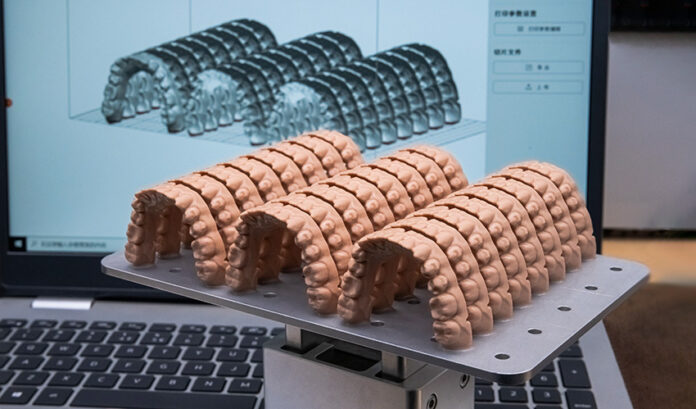
“A picture is worth a thousand words, but a 3D print is worth a thousand pictures.” As technology continuously shapes the medical field, the transformation of orthodontics is notable, particularly with the advent of 3D printing. The utilization of 3D printing in orthodontics is revolutionizing patient care, treatment plans, and the very essence of dental corrective procedures.
Orthodontics, traditionally known for its metal braces and mold-based impressions, is now entering a new era. By blending the innovative capabilities of a 3d printer orthodontics, practitioners can offer more precise and personalized solutions.
Basic Understanding of 3D Printing
What is 3D Printing? 3D printing, or additive manufacturing, involves creating a three-dimensional object by laying down successive layers of material. This process has revolutionized numerous industries, and its implications in the medical field, especially orthodontics, are profound.The breakthrough came when professionals began using first accessible large resin 3D printer, which allowed for more detailed and larger-scale prints in the orthodontic sector.
Materials Used in 3D Printing for Orthodontics
From biocompatible resins to polymers, the choice of materials plays a pivotal role in ensuring durability, accuracy, and safety. As technology advances, we are witnessing an expansion in the diversity and adaptability of materials suitable for 3D printing orthodontics.
Benefits of Using 3D Printing in Dental Practices
Besides accuracy, 3D printing offers cost savings, reduces waste, and ensures a comfortable patient experience. With streamlined processes and the innovative capabilities of an orthodontic 3D printer, orthodontists can now create tools and appliances with unparalleled precision. This advancement is particularly beneficial for patients, as it means fewer adjustments and less discomfort. Moreover, the use of a dedicated orthodontic 3D printer means faster production times and the possibility of producing multiple appliances simultaneously, leading to shorter waiting periods and more efficient treatment schedules for patients.
3D Scanning in Orthodontics
Traditional Impressions vs. Digital Impressions: The days of uncomfortable mouth molds are dwindling. With the advent of advanced technology like the orthodontics 3D printer, the landscape of dental impressions is undergoing a radical transformation. Digital impressions, facilitated by 3D scanners, not only provide a more pleasant experience for the patient but also pave the way for direct interfacing with these printers. This synergy between scanning and printing ensures that orthodontists can swiftly transition from scan to model, expediting procedures and providing real-time solutions. The added precision of an orthodontics 3D printer results in highly accurate dental appliances, marking a significant leap from traditional methodologies.
Advantages of Digital Scanning
Precision in digital scans means a significant reduction in errors. With the advancements of the 3D printer for orthodontics, the translation of these scans into tangible models has become more accurate and efficient. The process is swift, and the collaboration of digital scanning with orthodontic 3D printers ensures that the resultant digital model is not just a visualization but can be turned into a physical replica within minutes. This cutting-edge approach offers orthodontists an unparalleled view of the patient’s dental structure, while also ensuring that the final appliances, whether aligners or retainers, have a comfortable and precise fit. Furthermore, the adaptability and precision of these printers mean that even intricate orthodontic devices can be crafted with meticulous detail, reducing the need for multiple adjustments and patient visits.
The Process of Digital Scanning
After placing a scanner inside a patient’s mouth, a digital image is rendered in real-time. This image, a complete replica of the patient’s teeth and gums, becomes the foundation for the subsequent 3D printing process. The innovation doesn’t stop there. With the advancement of technology, there is now the possibility to 3D print braces directly from these digital imprints. The concept of being able to 3D print your own braces at home may sound futuristic, but with the rapid developments in this sector, it’s not far from becoming a reality. This evolution would revolutionize orthodontic treatments, making it more accessible and customizable. By merging digital scanning with the ability to 3D print braces, orthodontic care is becoming more efficient and tailored to individual needs, heralding a new age of dental care.
Creating Orthodontic Models
From Digital Scan to 3D Model Once the digital scan is secured, it’s fed into specialized software. This software communicates with the 3D printer in orthodontics, instructing it to lay down the chosen material layer by layer, ultimately creating an exact 3D replica of the patient’s dental structure.
Precision in Replicating Tooth Structures
This method ensures an exactness that traditional mold-based impressions simply can’t match. Each crevice, tooth alignment, and even minute deviations are captured and replicated. One of the standout advancements leveraging this precision is the creation of clear aligners, notably Invisalign. The Invisalign 3D printing process means that each set of aligners is tailored perfectly to the patient’s current dental structure, guiding teeth to their desired positions over time. The 3D printing Invisalign method has dramatically transformed orthodontic treatments, allowing for a discreet, comfortable, and efficient teeth-straightening solution. This modern approach not only enhances patient comfort but also reduces the time taken from diagnosis to the delivery of a personalized treatment plan, elevating the patient experience to unprecedented levels.
Benefits
The advantages of utilizing modern technology in orthodontics are manifold: minimal waste, swift production, and unmatched customization. Each model becomes a mirror reflection of the individual’s oral structure, allowing for bespoke treatment plans. One groundbreaking example of this innovation is the 3D printed Invisalign. These aligners, produced using high-precision 3D printing, ensure that every patient receives a set that fits seamlessly, maximizing comfort and treatment efficiency. With the integration of 3D printing, the creation of Invisalign has become faster and more precise, allowing orthodontists to cater to a wider range of dental complexities while assuring optimal results for each patient. This evolution symbolizes the convergence of technology and medical expertise, paving the way for a new era in orthodontic care.
3D Printing of Orthodontic Appliances
Clear Aligners One of the most significant advancements thanks to 3D printing in orthodontics is the production of clear aligners. These nearly invisible teeth-straightening tools are custom-made using 3D printers, providing a more aesthetic and comfortable alternative to metal braces.
Retainers
Post-treatment, many patients require retainers to maintain their newly aligned teeth. 3D printing ensures these retainers fit perfectly, minimizing discomfort and maximizing efficacy.
Spacers and Other Custom Tools
From spacers to other orthodontic tools, 3D printing’s precision and efficiency mean every tool can be tailored to each patient, enhancing treatment outcomes.
Benefits of 3D Printing in Orthodontics
The integration of 3D printing brings forth numerous advantages. Cost-effectiveness is a standout, with orthodontists being able to reduce overheads and pass savings onto patients. Treatment times are expedited, ensuring patients receive care promptly. Most importantly, patient experience is greatly enhanced – both in comfort and in treatment outcomes.
Challenges & Considerations
However, with all its benefits, there are considerations. The technology, while advanced, still has limitations. Ensuring the sterility of 3D printed tools is paramount, and there’s an ongoing need for practitioners to stay updated with training and software advancements.
Future of 3D Printing in Orthodontics
The horizon looks promising. With the potential of bio-printing, we might soon see the growth of real dental tissues. AI and machine learning promise even greater precision, hinting at an era where orthodontic treatments could be even more personalized and effective.
Conclusion
The fusion of 3D printing orthodontics is an exemplar of how technology can reshape industries. As we look to the future, it’s clear that this synergy will continue to redefine orthodontic practices, benefiting practitioners and patients alike










